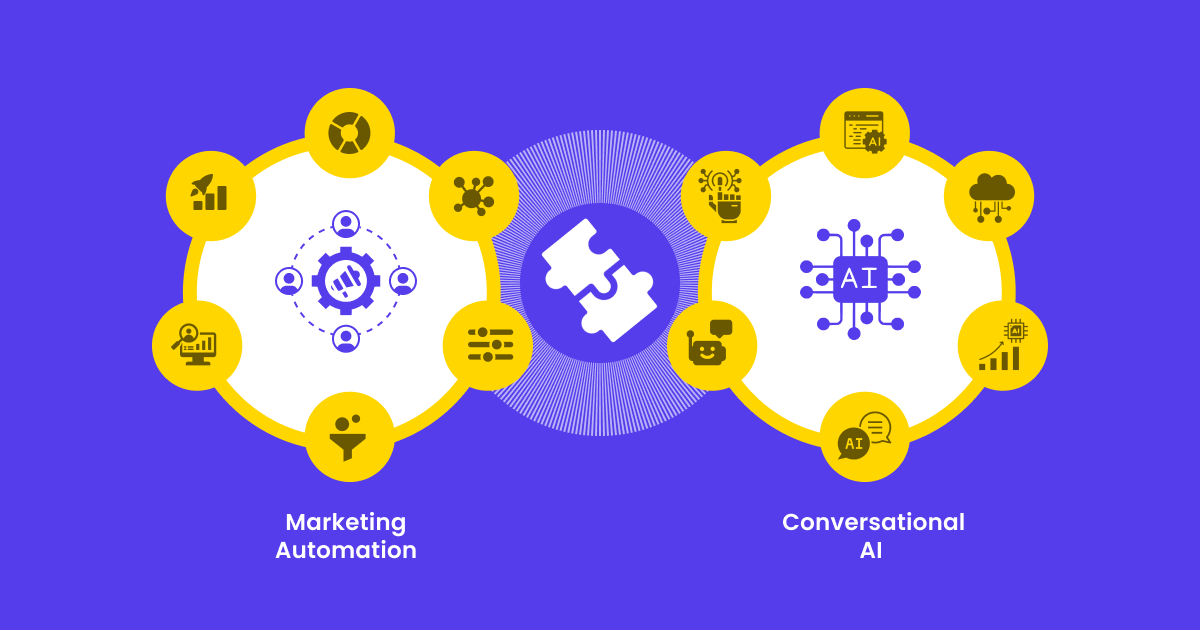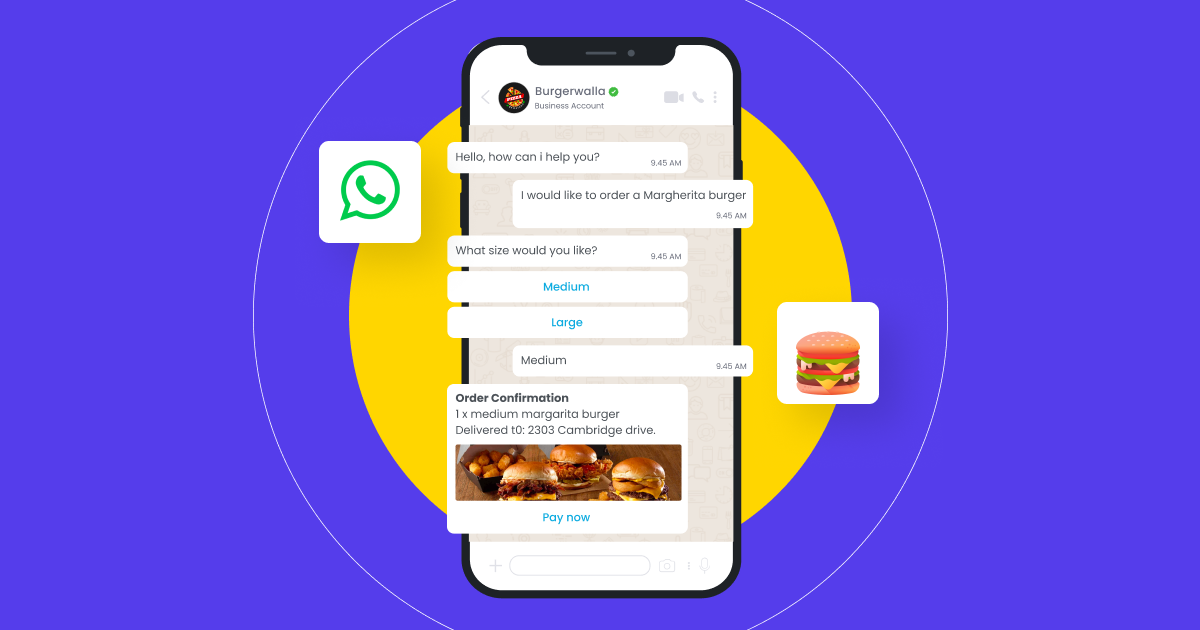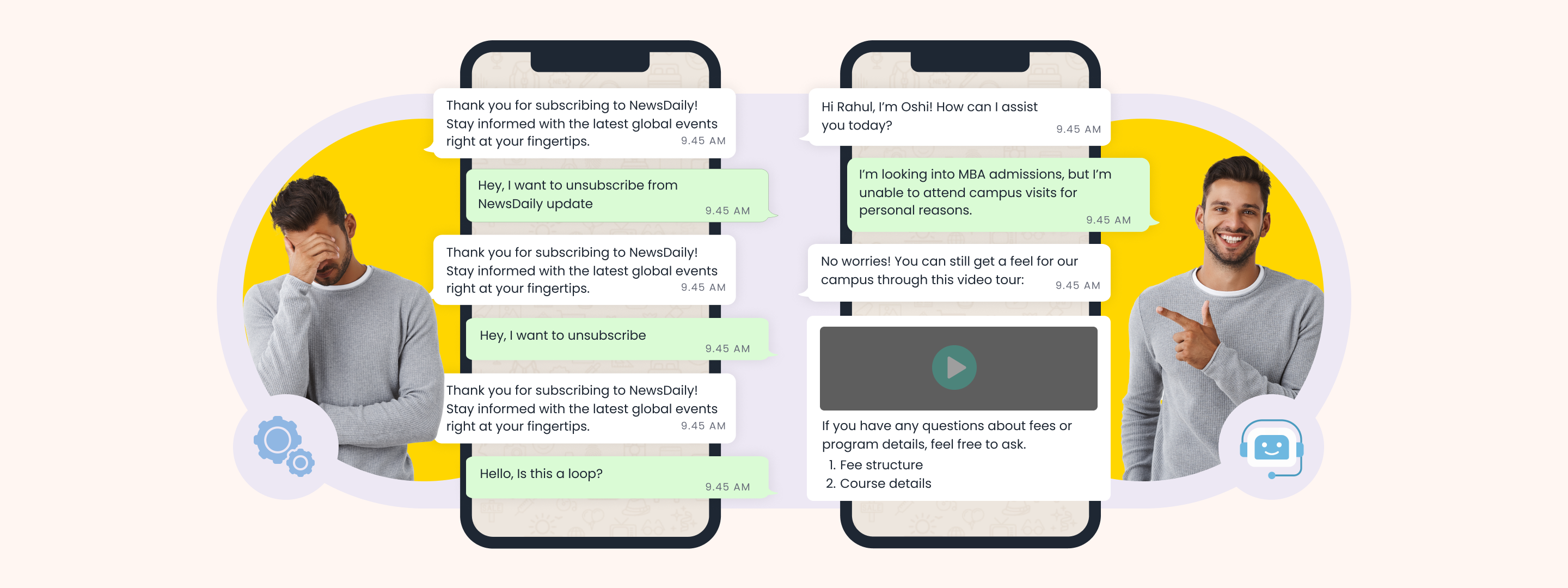In recent years, marketing automation has undergone a significant transformation, leading to a surge in users seeking customized shopping experiences. With rapidly changing customer expectations, the intersection of Marketing Automation and Conversational AI stands out as a game-changer.
In fact, there’s an interesting trend known as the “replacement wave,” where businesses are upgrading to AI-powered solutions, replacing older automation tools.
This shift is due to the old system’s reliance on rule-based models, which restricts interactions to predefined questions.
As we navigate through 2024, prioritizing a seamless Customer Experience (CX) is more important than ever. Brands today must ensure that every customer interaction with them is smooth, consistent, and satisfying. According to research, 86% of shoppers are willing to pay more for a great customer experience, and around 46% of customers will buy more when given a personalized experience.
By fusing marketing automation with AI-driven technologies, brands can create a unified ecosystem that enables them to build individualized and consistent experiences at scale.
This blog gives you an in-depth tour of how to leverage the power of conversational AI with marketing automation tools in tandem to build seamless customer interactions that translate to failproof conversions.
Unification of Conversational AI and Customer Engagement Platforms

Combining the strengths of Conversational AI and Customer Engagement is an effective approach to deliver tailored experiences. Integrating these two powerful tools can help you streamline marketing processes and deliver consistent experiences across the board.
But before getting into how the integration works, let’s take a detour of how each of these platforms operates independently:
Customer Engagement Platform (CEP)
A customer engagement platform with an embedded customer data platform (CDP) enables personalized interactions across email, social media, chat, and SMS. It consolidates data for insights into customer behavior, streamlines communication through automation, and ensures consistency and improvement in engagement strategies.
Conversational AI
Who doesn’t enjoy a friendly, human-like conversation with their favorite brands?
Conversational AI is the tech that makes this possible. Conversational AI makes it happen, using advanced algorithms like NLP and ML to understand and respond to queries just like a human would. Whether through chatbots or virtual agents, this technology ensures smooth, engaging conversations that improve over time.
It’s like having a virtual assistant at your service around the clock.
Research shows that 35% of people use chatbots to solve problems, and 40% of shoppers don’t mind if they’re assisted by AI or humans, as long as they get answers. With this level of adoption, 64% of businesses see chatbots as a way to offer more personalized customer support.
By integrating these technologies, you can deliver personalized experiences efficiently, optimizing marketing efforts with customer engagement and data-driven insights.
Here are some of the key benefits of integrating CEPs with Conversational AI:
1. Access to Rich Conversational Data:
Utilizing the Conversational AI and CEP duo provides access to a wealth of conversational data. This data includes insights from customer interactions across multiple channels, such as websites, social media platforms, and messaging apps. By combining and analyzing this data, you can build comprehensive customer profiles, gaining a deeper understanding of their needs.
2. Hyper Personalized Experiences:
It helps deliver real-time hyper-personalized experiences by leveraging the insights gained from your customer interactions. Gaining a better understanding of individual preferences and behaviors enables you to deliver tailored recommendations that meet each customer’s specific needs. This level of personalization leads to increased loyalty, satisfaction, and repeat business.
3. Intelligent Retargeting & Engagement Campaigns:
Analyzing customer behavior and interactions can help you identify opportunities for effective retargeting campaigns. It lets you send relevant offers or reminders based on past brand interactions.
Integrated data sets further equip you to improve contextual engagement across various channels with intelligent product or service recommendations, boosting relevance and conversions.
Transitioning from Third Party to Conversational First-Party Data

At the core of every marketing effort lies an insightful data bank concocted via various advertising campaigns that form the cornerstone of your engagement strategy.
Amidst the phasing out of third-party cookies and mounting privacy concerns among consumers, businesses are confronted with the need to acquire more substantial data.
That’s where conversational first-party data comes in handy.
It’s all about direct interactions with customers through chatbots, messaging apps, and voice assistants. Unlike other data, this one’s straight from the source, giving accurate and authentic insights like customer sentiments and preferences. By blending these insights with what you already know about your customers, you can create complete profiles, offer personalized recommendations, and craft targeted messages that really connect.
Harnessing the Power of Two-Way Communication
Gone are the days when a monologue ad would suffice to get the audience’s attention. Today’s customers seek a two-way dialogue with their brands. They want to ask questions, seek answers, and seek them fast. AI-powered chatbots do precisely that.
With its intelligent ability, it interprets and responds to human language in a nuanced and contextually relevant manner. It utilizes advanced algorithms and machine learning techniques to comprehend the meaning behind user queries. It also detects emotional tones or sentiments expressed and infers the user’s underlying intent or purpose so as to resonate and indulge in a two-way conversation.
These systems are versatile and can be adapted into any domain-specific model to address challenges within a particular industry or field. Brands can harness the dynamic nature of two-way communication channels like WhatsApp to seamlessly integrate domain-specific models, catering to diverse needs across the customer journey. With its widespread usage and accessibility, WhatsApp has become the go-to channel for businesses to engage in real-time conversations with their customers.
For example, in the banking sector, these models can analyze transaction data on WhatsApp to offer personalized financial advice, detect fraudulent activities, and provide proactive customer support, thus showcasing its versatility in addressing various scenarios from initial engagement to long-term relationship management.
Delivering Authentic Omnichannel Customer Engagement Experience
To engage your audience effectively, you need an omnichannel strategy that seamlessly integrates customer experiences across all touchpoints.
With WebEngage’s omnichannel capabilities, you can design automated workflows to engage customers across websites, apps, WhatsApp, and more. The platform’s Journey Designer ensures timely and relevant campaigns without manual intervention, delivering targeted messages based on demographic and behavioral data. You can do A/B testing and track the performance of your multichannel campaigns, all under a single umbrella.
Additionally, you can implement AI-driven chatbots to enhance customer interactions, providing context-aware support and personalized solutions 24/7.
Rise of Conversational Commerce: Building ‘One-Channel’ Experiences

Each time a customer abandons a chat or gets redirected to a website, there’s a missed opportunity to complete a transaction. While conversational AI enables you to build seamless interactions. It’s not always a foolproof strategy to get conversions. Your customers migrate from app to app at their convenience, making it difficult for you to keep track of their movements and nudge them to take the desired action.
Conversational AI can help you deliver human-like interactions to generate leads. However, you need a more advanced mechanism to get those leads to turn into potential customers.
Conversational commerce is a smart choice for marketers to not only interact with customers on a single platform but also prompt a transaction within the same app environment, building a ‘one-channel’ experience. It uses chatbots and messaging apps like WhatsApp to help customers shop online. This improves customer service and engagement, leading to more sales.
Conversational commerce is the new breeding ground for businesses to sell products and services through messaging apps. It allows customers to chat with businesses and ask questions about products, and even make purchases without leaving the messaging app.
The Future is Conversational
In the fiercely competitive marketing world, incomplete customer insights hinder a brand’s ability to understand its audience fully. It restricts their capacity to adapt and innovate in response to evolving market demands. Furthermore, this disconnection can result in piles of siloed data, curtailing a holistic view of customer interactions. All these can result in inaccurate promotions or messages, rendering marketing efforts futile.
Moreover, fragmented data silos can lead to revenue loss due to missed opportunities for upselling and cross-selling without insights from conversational interactions. This directly impacts the bottom line.
Integrating conversational AI addresses these challenges by bridging the gap between marketing automation and seamless customer interactions. By leveraging conversational data, brands gain deeper insights into customer preferences, behaviors, and sentiments, enabling them to personalize marketing efforts effectively. This integration not only enhances marketing precision but also fosters seamless customer experiences, driving engagement, and, ultimately, business success.
Conversational AI is the tomorrow of marketing, if you want to tap into this new data world weaved from authentic conversions, hit that DEMO button today!








 Vanhishikha Bhargava
Vanhishikha Bhargava

